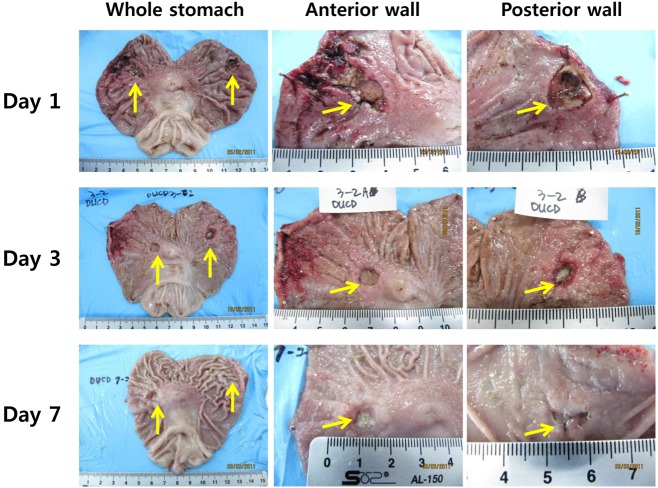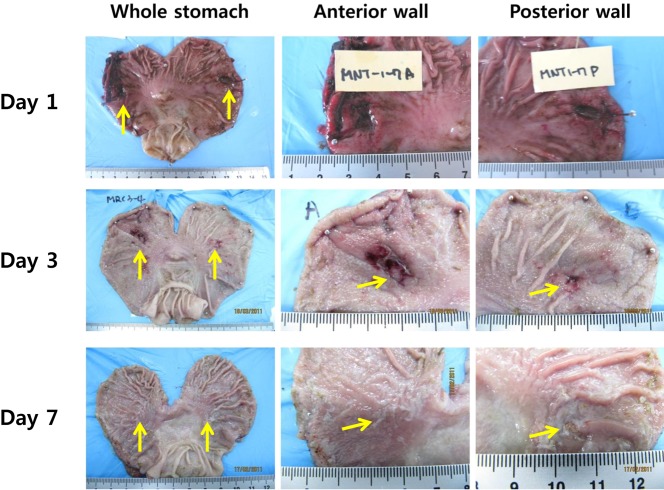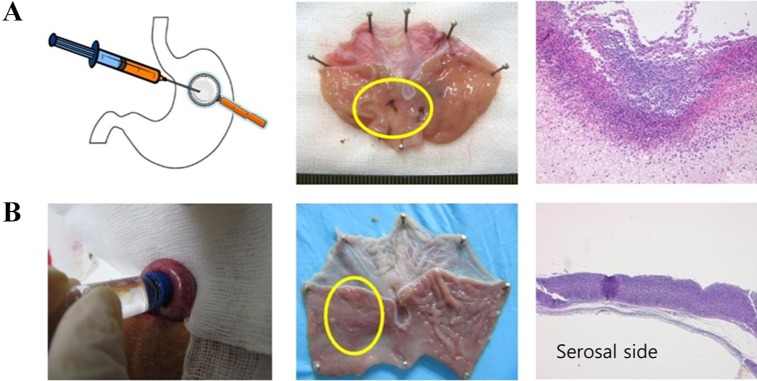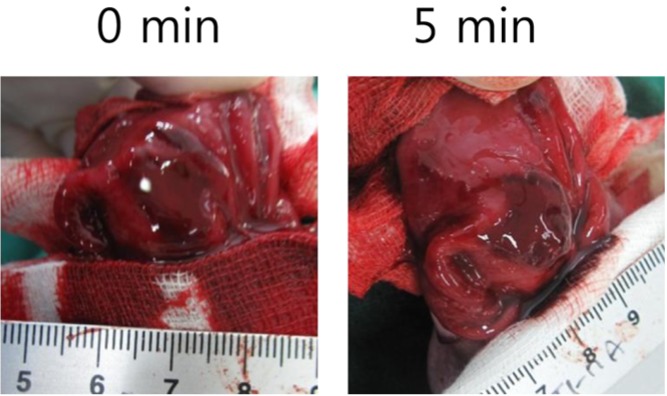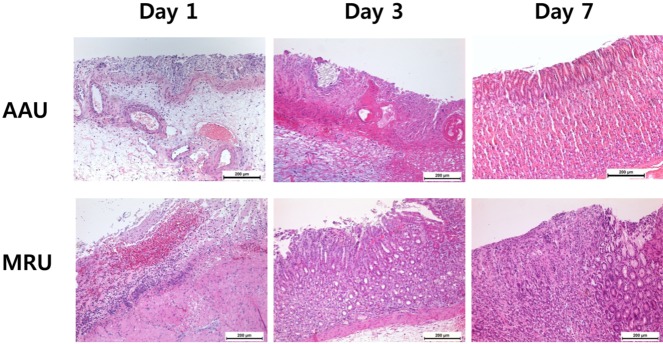Lab Anim Res.
2013 Jun;29(2):96-102. 10.5625/lar.2013.29.2.96.
Rabbit gastric ulcer models: comparison and evaluation of acetic acid-induced ulcer and mucosectomy-induced ulcer
- Affiliations
-
- 1Utah-Inha DDS and Advanced Therapeutics Research Center, Incheon, Korea. ldh@inha.ac.kr
- 2Division of Gastroenterology & Hepatology, Inha University Hospital, Incheon, Korea.
- 3Clinical Research Center and NCEED, School of Medicine, Inha University, Incheon, Korea. sugeun.yang@inha.ac.kr
- KMID: 1431341
- DOI: http://doi.org/10.5625/lar.2013.29.2.96
Abstract
- In this study, we examined rabbit gastric ulcer models that can serve as more clinically relevant models. Two types of ulcer model were studied: acetic acid-induced ulcers (AAU) and mucosal resection-induced ulcers (MRU). For AAU, rabbit gastric mucosa was exposed by median laparotomy and treated with bottled acetic acid. MRU was examined as a model for endoscopic mucosal resection (EMR). Normal saline was injected into the submucosal layer and the swollen mucosa was resected with scissors. Endoscopic mucosal resection (EMR) is frequently performed for treatment of early gastric cancers. This procedure inevitably leads to ulcers and bleeding. Bleeding control is the major concern in endoscopic mucosectomy, and some endoscopic hemostatic agents are currently under clinical and preclinical studies. MRU was developed as a model for these induced ulcers and the evaluation of the healing process. The clinical relevancy of those models was compared with that of rat models. Progressive healing was observed for 7 days based on histology. Rabbit models demonstrate round, deep ulcers with clear margins and well-defined healing stages that were difficult to define in rat models.
Keyword
MeSH Terms
Figure
Reference
-
1. Lam SK. Etiology and pathogenesis of peptic ulcer. J Gastroenterol. 1994; 29(Suppl 7):39–54. PMID: 7921153.2. Blaser MJ. Hypotheses on the pathogenesis and natural history of Helicobacter pylori-induced inflammation. Gastroenterology. 1992; 102(2):720–727. PMID: 1732141.
Article3. Kurata JH, Haile BM. Epidemiology of peptic ulcer disease. Clin Gastroenterol. 1984; 13(2):289–307. PMID: 6378441.
Article4. Ahmad NA, Kochman ML, Long WB, Furth EE, Ginsberg GG. Efficacy, safety, and clinical outcomes of endoscopic mucosal resection: a study of 101 cases. Gastrointest Endosc. 2002; 55(3):390–396. PMID: 11868015.
Article5. Groenen MJ, Kuipers EJ, Hansen BE, Ouwendijk RJ. Incidence of duodenal ulcers and gastric ulcers in a Western population: back to where it started. Can J Gastroenterol. 2009; 23(9):604–608. PMID: 19816622.
Article6. Adamu MA, Weck MN, Gao L, Brenner H. Incidence of chronic atrophic gastritis: systematic review and meta-analysis of follow-up studies. Eur J Epidemiol. 2010; 25(7):439–448. PMID: 20585973.
Article7. Okabe S, Roth JL, Pfeiffer CJ. A method for experimental, penetrating gastric and duodenal ulcers in rats. Observations on normal healing. Am J Dig Dis. 1971; 16(3):277–284. PMID: 5554507.8. Okabe S, Amagase K. An overview of acetic acid ulcer models--the history and state of the art of peptic ulcer research. Biol Pharm Bull. 2005; 28(8):1321–1341. PMID: 16079471.9. Darbari A, Kalloo AN, Cuffari C. Diagnostic yield, safety, and efficacy of push enteroscopy in pediatrics. Gastrointest Endosc. 2006; 64(2):224–228. PMID: 16860073.
Article10. Carmack SW, Genta RM, Schuler CM, Saboorian MH. The current spectrum of gastric polyps: a 1-year national study of over 120,000 patients. Am J Gastroenterol. 2009; 104(6):1524–1532. PMID: 19491866.
Article11. Gotoda T. Endoscopic resection of early gastric cancer. Gastric Cancer. 2007; 10(1):1–11. PMID: 17334711.
Article12. Ono H, Kondo H, Gotoda T, Shirao K, Yamaguchi H, Saito D, Hosokawa K, Shimoda T, Yoshida S. Endoscopic mucosal resection for treatment of early gastric cancer. Gut. 2001; 48(2):225–229. PMID: 11156645.
Article13. Miyashita M, Tajiri T, Maruyama H, Makino H, Nomura T, Sasajima K, Yamashita K. Endoscopic mucosal resection scissors for the treatment of early gastric cancer. Endoscopy. 2003; 35(7):611–612. PMID: 12822098.
Article14. Kojima T, Parra-Blanco A, Takahashi H, Fujita R. Outcome of endoscopic mucosal resection for early gastric cancer: review of the Japanese literature. Gastrointest Endosc. 1998; 48(5):550–554. 554–555. PMID: 9831855.
Article15. Okano A, Hajiro K, Takakuwa H, Nishio A, Matsushita M. Predictors of bleeding after endoscopic mucosal resection of gastric tumors. Gastrointest Endosc. 2003; 57(6):687–690. PMID: 12709698.
Article16. Yamaguchi Y, Katsumi N, Tauchi M, Toki M, Nakamura K, Aoki K, Morita Y, Miura M, Morozumi K, Ishida H, Takahashi S. A prospective randomized trial of either famotidine or omeprazole for the prevention of bleeding after endoscopic mucosal resection and the healing of endoscopic mucosal resection-induced ulceration. Aliment Pharmacol Ther. 2005; 21(Suppl 2):111–115. PMID: 15943857.
Article17. Holster IL, Poley JW, Kuipers EJ, Tjwa ET. Controlling gastric variceal bleeding with endoscopically applied hemostatic powder (Hemospray™). J Hepatol. 2012; 57(6):1397–1398. PMID: 22864337.18. Giday SA, Kim Y, Krishnamurty DM, Ducharme R, Liang DB, Shin EJ, Dray X, Hutcheon D, Moskowitz K, Donatelli G, Rueben D, Canto MI, Okolo PI, Kalloo AN. Long-term randomized controlled trial of a novel nanopowder hemostatic agent (TC-325) for control of severe arterial upper gastrointestinal bleeding in a porcine model. Endoscopy. 2011; 43(4):296–299. PMID: 21384319.
Article19. Ghoshal NG, Bal HS. Comparative morphology of the stomach of some laboratory mammals. Lab Anim. 1989; 23(1):21–29. PMID: 2724910.
Article20. Svestka T, Krechler T, Zák A, Fabry TL, Zhang ZG. [Effect of fasting on gastric mucosa thickness: experimental study in laboratory rats]. Cas Lek Cesk. 2003; 142(12):751–754. PMID: 14746225.
- Full Text Links
- Actions
-
Cited
- CITED
-
- Close
- Share
- Similar articles
-
- Three Cases of Coexistence of Gastric Cancer and Duodenal Ulcer
- The effect of verapamil on cysteamine-induced duodenal ulcer in the rat
- A Case of Coexistence of Gastric Cancer and Duodenal Ulcer
- Evaluation of the Location of Peptic Ulcer
- Bile Ductular Proliferation in the Gastric Wall after Gastric Ulcer Penetration into the Liver

